Kapp Putsch
The Kapp Putsch, also known as the Kapp–Lüttwitz Putsch, named after its leaders Wolfgang Kapp and Walther von Lüttwitz, was an attempted coup in Berlin on 13 March 1920. Its goal was to undo the German Revolution of 1918–1919, overthrow the Weimar Republic, and establish an autocratic government in its place. It was supported by parts of the Reichswehr, and nationalist and monarchist factions.
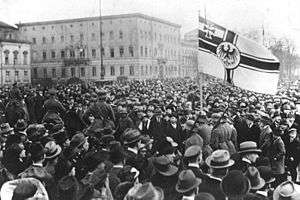
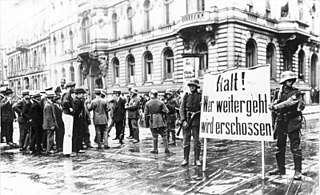
The legitimate German government was forced to flee the city. The coup failed after a few days, when large sections of the German population followed a call by the government to join a general strike. Most civil servants refused to cooperate with Kapp and his allies. Despite its failure, the putsch had significant consequences for the future of the Weimar Republic. It was one of the causes of the Ruhr uprising of March 1920, which the government suppressed by military force, after having dealt leniently with leaders of the putsch. These events polarized the electorate, resulting in a shift in the majority after the June 1920 Reichstag elections.
Background
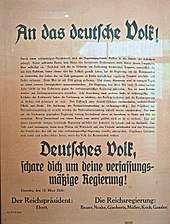
After Germany had lost World War I (1914–1918), the German Revolution of 1918–1919 ended the monarchy. The German Empire was abolished and a democratic system, the Weimar Republic, was established in 1919 by the Weimar National Assembly. Right-wing nationalist and militarist circles opposed the new republic and promoted the stab-in-the-back myth, claiming that the war had been lost only because the efforts of the undefeated German military had been undermined by civilians at home.[1]
In 1919–20, the government of Germany was formed by the Weimar Coalition, consisting of the Social Democratic Party (SPD), German Democratic Party (DDP, left-of-centre liberals), and Zentrum (conservative Catholics). President Friedrich Ebert, Chancellor Gustav Bauer, and Defence Minister Gustav Noske were all members of the SPD. According to the constitution, the president was the commander-in-chief of the armed forces, represented in peace time by the Minister of Defence. The most senior officer of the land forces was called Chef der Heeresleitung, a post held in early 1920 by General Walther Reinhardt.
Gustav Bauer was obliged to sign the Treaty of Versailles in 1919, even though he disagreed with it. The treaty had been dictated by the victorious Allies of World War I; it forced Germany to assume sole responsibility for the war, reduced the area of Germany and imposed reparation payments and military restrictions on the nation.[1] In early 1919, the strength of the Reichswehr, the regular German army, was estimated at 350,000, with more than 250,000 men enlisted in the various Freikorps ("free corps"), volunteer paramilitary units, largely consisting of returning soldiers from the war. The German government had repeatedly used Freikorps troops to put down Communist uprisings after the war. Under the terms of the Treaty of Versailles, which came into effect on 10 January 1920, Germany was required to reduce its land forces to a maximum of 100,000 men. The initial deadline was set for 31 March 1920 (later extended to the end of the year).[2]:25 Freikorps units were expected to be disbanded. Since the reason for their creation—internal repression—had become obsolete with the crushing of the leftist uprisings, they were becoming a threat to the government.[3]:216 Some senior military commanders had started discussing the possibility of a coup as early as July 1919.[4]
Coup
Run-up to the coup
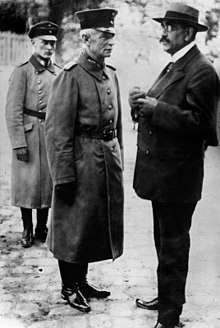
Although the putsch has been named after Wolfgang Kapp, a 62-year-old nationalist East Prussian civil servant, who had been planning a coup against the republic for a while, it was instigated by the military; Kapp played a supporting role.[3]:217[5]:50 On 29 February 1920, the Defence Minister Noske ordered the disbandment of two of the most powerful Freikorps, the Marinebrigade Loewenfeld and Marinebrigade Ehrhardt. The latter numbered from 5,000–6,000 men and had been stationed at the Truppenübungsplatz Döberitz, near Berlin, since January 1920.[3]:217[6] An elite force, it had been created from former Imperial Navy officers and NCOs, boosted later by Baltikumer (those who had fought the Bolsheviks in Latvia in 1919). During the civil war in 1919, the brigade had seen action in Munich and Berlin. It was extremely opposed to the democratic government of Friedrich Ebert.[3]:217
Its commander, Korvettenkapitän Hermann Ehrhardt, declared that the unit would refuse its dissolution.[5]:51 On 1 March, it staged a parade without inviting Noske.[3]:218 General Walther von Lüttwitz, in command of all the regular troops in and around Berlin (Gruppenkommando I), the highest ranking general in the army at the time and in command of many Freikorps, said at the parade that he would "not accept" the loss of such an important unit. Several of Lüttwitz' officers were horrified at this open rejection of the government's authority and tried to mediate, by setting up a meeting between Lüttwitz and the leaders of the two major right-wing parties. Lüttwitz listened to and remembered their ideas but was not dissuaded from his course of action.[3]:218 Noske then removed the Marinebrigade from Lüttwitz' command and assigned it to the leadership of the Navy, hoping that they would disband the unit. Lüttwitz ignored the order but agreed to a meeting with President Ebert, suggested by his staff.
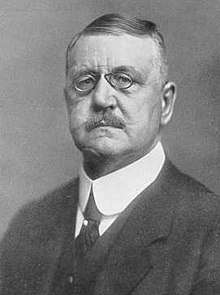
In the evening of 10 March, Lüttwitz came with his staff to Ebert's office. Ebert had also asked Noske to attend. Lüttwitz, drawing on demands by the right-wing parties and adding his own, now demanded the immediate dissolution of the National Assembly, new elections for the Reichstag, the appointment of technocrats (Fachminister) as Secretaries for Foreign Affairs, Economic Affairs and Finance, the dismissal of General Reinhardt, appointment of himself as supreme commander of the regular army and the revocation of the orders of dissolution for the Marinebrigaden. Ebert and Noske rejected these demands and Noske told Lüttwitz that he expected his resignation the next day.[3]:219
Lüttwitz went to Döberitz on 11 March and asked Ehrhardt whether he would be able to occupy Berlin that evening. Ehrhardt said he needed another day but in the morning of 13 March he could be in the centre of Berlin with his men. Lüttwitz gave the order and Ehrhardt began the preparations. It was only at this point that Lüttwitz brought the group known as Nationale Vereinigung into the plot. These included German National People's Party (DNVP) member Wolfgang Kapp, retired general Erich Ludendorff and Waldemar Pabst, who had been behind the murder of Karl Liebknecht and Rosa Luxemburg in January 1919 and Traugott von Jagow, the last Berlin head of police in the old Reich.[2]:25[3]:219[5]:50–51 Their goal was to establish an authoritarian regime (though not a monarchy) with a return to the federal structure of the Empire.[7] Lüttwitz asked them to be ready to take over the government on 13 March. The group was unprepared but agreed to the schedule set by Lüttwitz. One factor making them support quick action was that sympathetic members of the Sicherheitspolizei in Berlin informed them that warrants for their arrest had been issued that day.[3]:219–220
Lüttwitz was not dismissed but suspended from his post on 11 March.[5]:51 To defend the government, Noske ordered two regiments of Sicherheitspolizei and one regular regiment to take position in the government quarter but doubted that a putsch was imminent.[3]:220 The regimental commanders decided not to follow orders to shoot, a decision that received the approval of Chef des Truppenamts General Hans von Seeckt.[3]:220
Occupation of Berlin
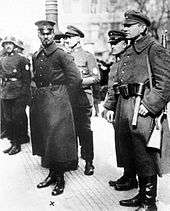
The reluctance to shed blood was one-sided. On the evening of 12 March, Ehrhardt ordered his brigade to march into Berlin, to "ruthlessly break any resistance" (jeden Widerstand rücksichtslos zu brechen) and to occupy the centre of the city with the government buildings. The Brigade, sporting swastikas on their helmets and vehicles, started off towards Berlin at around 10:00 pm. An hour later the Gruppenkommando knew about it and informed Noske. Two general officers met Ehrhardt and convinced him to give the government a chance to surrender before being taken into custody, assuming that all of Lüttwitz' demands were accepted by 7:00 am. This was reported to Noske who met with Ebert. Ebert then called a cabinet meeting for 4:00 am. At 1:00 am Noske asked the senior commanders to his office in the Bendlerblock.[3]:221–222
Noske asked the commanders to defend the government buildings but was turned down. All but two of the officers (one of them was Reinhardt, Chef der Heeresleitung) refused to follow an order to shoot at the rebel troops. Some suggested negotiations, others claimed that the troops would not understand an order to fire, some argued that the regular units would not be able to defeat the elite Marinebrigade. Seeckt spoke about comradeship.[3]:222 His exact words were not recorded, but have been reported as: "troops do not fire on troops. So, you perhaps intend, Herr Minister, that a battle be fought before the Brandenburger Tor between troops that have fought side by side against a common enemy? When Reichswehr fires on Reichswehr all comradeship within the officers' corps will have vanished".[8] Others have quoted Seeckt's words as the even more succinct: "Reichswehr does not fire on Reichswehr!"[2]:26
Noske, depressed enough by the disloyalty of the military to speak about suicide to an aide, reported to the cabinet at 4:00 am.[3]:222 At a confused meeting at the Reichskanzlei, the undefended cabinet took two decisions: to flee the city and to issue a call for a general strike. These were not unanimous, the Vice-Chancellor Eugen Schiffer and some of the other non-SPD ministers refused to leave the city, to preserve the opportunity to negotiate with the putschists. Only Ebert and the SPD ministers signed the call for a general strike. At 6:15 am they had to interrupt the meeting and flee. Within ten minutes of their departure, the Marinebrigade reached the Brandenburger Tor, where it was met by Lüttwitz, Ludendorff, Kapp and their followers. Shortly thereafter, Kapp's men moved into the Reichskanzlei.[3]:222 Supported by a battalion of regular Reichswehr, they occupied the government quarter.[2]:26
Kapp declared himself Chancellor (Reichskanzler) and formed a provisional government.[2]:26 Lüttwitz served as commander of the armed forces and Minister of Defence. Several well-known conservatives and former secretaries of state were invited to assume government positions but declined.[9] International con-man Ignaz Trebitsch-Lincoln became Kapp's press censor.[10]
Reactions
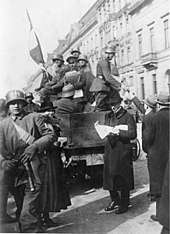
There was no military resistance to the putsch; the regular troops in Berlin, Sicherheitspolizei, navy, the army commands of East-Prussia, Pomerania, Brandenburg and Silesia, formally accepted the new minister of defence and Reichskanzler.[3]:224[11] Admiral Adolf von Trotha, the navy commander, came out in support of the coup as soon as he learned of it.[12] In Bavaria, the Reichswehr toppled the Social Democratic state government and replaced it with the right-wing regime of Gustav Ritter von Kahr. In the rest of the Reich, the commanders of the Wehrkreise (military districts) did not declare for or against Kapp but were not neutral and most sympathised more or less openly with the putschists.[3]:224 The upper echelons of the bureaucracy were still dominated by those who had risen to their positions under the Empire and most were sympathetic to the coup, whilst remaining outwardly neutral and biding their time. In the eastern provinces, the bureaucracy fell in line behind Kapp and Lüttwitz.[3]:224–225
The government moved to Dresden, where they hoped to get support from Generalmajor Maercker but he had been ordered by Berlin to take them into "protective custody" and they moved on to Stuttgart.[3]:225–226 The cabinet proclamation on 13 March, calling on German workers to defeat the putsch by means of a general strike met with enormous success and received massive support from the working class. The majority unions, sympathetic to the government dominated by social democrats, joined the call for a strike on the same day, as did the Independent Social Democratic Party (USPD) and the Democratic Party; the Communist Party of Germany (KPD) followed one day later. In Berlin, the strike started on 14 March and by the next day it had spread all over the Reich. It was the most powerful strike in the history in Germany, involving up to 12 million workers. The country was paralysed. In Berlin the gas, water and power supply stopped.[3]:226[13]
Adolf Hitler, who had been in contact with the members of the Nationale Vereinigung and was eager to help the coup along, was flown into Berlin from Munich by the Army. The pilot was Robert von Greim, whom Hitler later appointed as the last commander of the Luftwaffe. He was met by striking workers at an airfield outside of Berlin, where he landed by mistake, and had to disguise himself.[14] Eventually Hitler could continue his flight together with Dietrich Eckart to Berlin, where they immediately went to the Reichskanzlei to meet Wolfgang Kapp. Hitler and Eckart were approached by Ignaz Trebitsch-Lincoln, who told them that Kapp had fled and the coup failed.[15]
Collapse
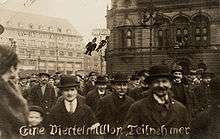
With the country paralyzed, Kapp and Lüttwitz were unable to govern; in Berlin, communication between military units was by courier only. The rank and file of the bureaucracy were on strike, and there were no newspapers. Proclamations asking the workers to return to their jobs, promises of new elections and even the threat of capital punishment for strikers remained without results and the putsch collapsed on 17 March, four days after it had begun.[3]:226 Kapp had put Vice-Chancellor Schiffer and the members of the Prussian state government into protective custody on 13 March but they were released the next day and on 15 March, negotiations began. Representatives of the democratic right, Oskar Hergt and Gustav Stresemann also participated. The four big centre-right parties (Democratic Party, Zentrum, German People's Party and German National People's Party) agreed that the main threat was now "bolshevism" and that they had to "win back" the officer corps. It was considered undesirable that Kapp and Lüttwitz should be toppled, they must be seen to resign voluntarily.[3]:229–230
The four parties, supported by some Social Democrats who had remained in Berlin, offered fresh elections, a cabinet reshuffle and an amnesty for all participants in the putsch, if Kapp and Lüttwitz were to resign. The putschists offered only the resignation of Kapp, and Lüttwitz tried to hold on for another day as head of a military dictatorship but his commanders deserted him. They suggested to Schiffer, in the absence of Ebert in charge of the government's affairs, that he appoint Seeckt as head of the Reichswehr, which Schiffer did in the name of Ebert. When Lüttwitz offered his resignation on 18 March, Schiffer accepted—again in Ebert's name—while granting him full pension rights. Schiffer also suggested Pabst and Lüttwitz should leave the country, until the National Assembly had decided on the question of an amnesty and even offered them false passports and money.[3]:229–230
On 18 March, Seeckt praised the discipline of the Marinebrigade Ehrhardt and the next day provided Ehrhardt with a written promise that he would not be arrested as long as he was in command of the brigade and the brigade left Berlin. When they were heckled by an unfriendly crowd of bystanders, they opened fire with machine guns, leaving twelve civilians dead and thirty severely wounded.[3]:231 Kapp remained in the country and only fled to Sweden in April.[13] Lüttwitz first went to Saxony and only later left for Hungary.[2]:26 Both men used passports provided by supporters in the police.[3]:231 Ehrhardt went into hiding in Bavaria.[2]:26
Aftermath
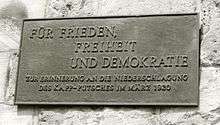
In 2009, Layton wrote, "At first sight the collapse of the Kapp Putsch could be viewed as a major success for the Weimar Republic. In the six days of crisis, it had retained the backing of the people of Berlin and had effectively withstood a major threat from the extreme right."[8] Among the grievances which Kapp and his followers had against the government were that the national assembly, which had been elected to serve temporarily, was beginning to act as a permanent Reichstag and that it seemed this assembly might revise the constitution with respect to the election of the President of the Republic, which would make the Reichstag, rather than the electorate, responsible for the Presidential election. As a consequence of the promise made to the putschists, the National Assembly was dissolved in April and the date of the general election for the first republican Reichstag was brought forward to 6 June so that the German people could express their feelings regarding the terms of the Versailles Treaty. All attempts to change the method of election for the presidency of the Republic were abandoned.[9] In the Reichstag elections of 6 June, the number of votes cast for the SPD and the Democratic Party fell by more than half, compared to the January 1919 elections, while the extreme right-wing German National People's Party (DNVP) (whose voters eventually switched to the Nazis) and the extreme left-wing USPD gained substantially. The Weimar Coalition lost its majority in parliament and would never regain it. The SPD had made a pact with the Army, which resulted in Communist workers being shot dead, so the Left was permanently fractured. Ebert told the Army it was free to arrange its own affairs, thereby forming a state-within-a-state implacably opposed to Weimar that eventually was central to the right-wing coup against the Prussian state government (half of German territory) in 1932. Essentially, the collapse of Weimar cannot be understood without understanding the Kapp Putsch and its consequences.
The effect of the Kapp-Lüttwitz Putsch throughout Germany were more lasting than in Berlin. In some parts of the country, the strike had turned into an armed revolt. The violence came from local military commanders who supported the new government and arrested pickets, which the workers resisted. In Thuringia and Saxony the military defeated the workers after bloody fights. In the Ruhr, the workers won and did not stop after the putsch in Berlin had collapsed. In what became known as the Ruhr uprising, a Red Ruhr Army went on the offensive. On 17 March it took Dortmund, on 18 March Hamm and Bochum and on 19 March Essen, causing the local Wehrkreiskommando at Münster to order a withdrawal. By 22 March, the Ruhr was under the control of the revolutionary workers.[3]:228–229
The legitimate government returned to Berlin on 20 March and asked for the general strike to be ended. To achieve this it offered some concessions to the unions, some of them made in bad faith.[3]:232 The unions (ADGB, Afa-Bund and DBB) demanded the creation of a new government made up of SPD and USPD, led by Carl Legien but only a new government based on the Weimar Coalition found a majority in the National Assembly and Hermann Müller (SPD) replaced Bauer as Chancellor.[2]:26 The government then tried to negotiate with workers who refused to lay down their arms, after the unions called off the strike on 22 March. When the negotiations failed, the revolt in the Ruhr was suppressed by Reichswehr and Freikorps in early April 1920. Hundreds of people were killed, many in summary executions, some committed by units that been involved in the putsch, including Marinebrigade Ehrhardt.[16] As in 1918–1919, those on the left had cause to accuse the SPD and the Ebert government of siding with the enemies of the workers and of the republic.[3]:229,233
The putsch left a rump of military conspirators such as Pabst and Ehrhardt, who found refuge in Bavaria under the right-wing government of Gustav von Kahr (itself an indirect product of the Kapp-Lüttwitz Putsch) and there attempted to organize plots against the republican constitution and government of Germany. The crisis in the relations of Bavaria with the Reich (August–September 1921) which ended in Kahr's resignation was a further phase of the same trouble.[9]
After the putsch Noske named Kapp, Pabst and Ehrhardt as being responsible, despite the support from much higher up in the army.[17] Most of the participants were granted an amnesty and on 2 August 1920, the Reichstag passed a law that exculpated crimes committed during the putsch and the subsequent Ruhr Uprising except those due to "cruelty" or "self-interest".[2]:27 Of 705 cases brought against civilians, only the prosecution of von Jagow ended with a guilty verdict.[5]:54 Freikorps and Reichswehr members were subject to military law and of 775 court martials, 486 cases were closed. 48 officers were removed from their posts, six resigned, the others were subject to mild disciplinary actions. The Marinebrigade Ehrhardt was dissolved in May 1920 but most of its members were allowed to join the Reichswehr where they had successful careers.[13] The courts were much harsher on the members of the Red Ruhr Army, many of whom were sentenced to lengthy terms of imprisonment.[2]:27
Kapp was arrested in Sweden on 16 April but not deported to Germany.[13] He voluntarily returned to Germany in April 1922 and died the same year in prison while awaiting trial.[13] Lüttwitz returned to Germany as part of an amnesty in 1924.[18] Gustav Noske was forced to resign by the unions on 22 March, as a condition for ending the general strike and because some in the SPD thought that he had not been tough enough facing up to the putschists; Otto Gessler succeeded Noske as Defence Minister.[19][20] General Reinhardt also resigned out of protest at Noske's dismissal. General Seeckt became his successor as Chef der Heeresleitung.[5]:54
Monument to the March Dead
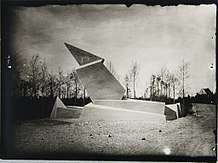
Between 1920 and 1922 a monument in honour of the workers who were killed in the wake of the Kapp Putsch was erected in the Weimar central cemetery. The memorial was commissioned by the Weimar Gewerkschaftskartell (Union Cartel), which conducted a competition to select a design. It was built according to plans submitted by the architectural office of Walter Gropius. Although Gropius had said that the Bauhaus should remain politically neutral, he agreed to participate in the competition of Weimar artists at the end of 1920.[21]
The monument was arranged around an inner space, in which visitors could stand. The repeatedly fractured and highly angular memorial rose up on three sides, as if thrust up from or rammed into the earth.[21]
The monument was destroyed by the Nazis in February 1936. They objected to it politically and considered it an example of "degenerate art", as Hitler characterized modern works.[22]
See also
- 1920 in Germany
- Rudolph Berthold#Death and gravestone
Footnotes
- Translation of the poster's text:
To the German people !
As a result of a lunatic coup de main, the government buildings of Berlin have fallen into the hands of mutineers. No political party, no man of sober-minded thought is behind these events. They are to be deplored. Since troops that are destined for discharge in Döberitz, namely [troops] from the Baltic, have supported this act of madness, the government—in order to avoid the spilling of blood—has spared the lives of the few regular troops located in Berlin and has departed Berlin. For enough blood has flowed since 1914. And this adventure will collapse in a few days from its intrinsic impracticality. The government has transferred its seat to Dresden. Everyone remains bound in obedience to the constitutional government. Only it can issue orders and payments. Any decree from another place is legally null. The soldiers of the national army have to defend the constitution, protect the president and government, and be obedient. To emulate the breaking of their oath by a number of officers is prohibited by duty and law. The dissolution of the national assembly is unconstitutional. The president of the national assembly has been requested to convene the national assembly again at once. Only a government based on the constitution can save Germany from sinking into darkness and blood. If Germany is led from one coup to another, then it is lost. A government resting on an act of violence lacks authority domestically and abroad. The people will starve if new troubles interrupt the economy and commerce and undermine the trust of the father land, which only a constitutional government earns. Colossal dangers loom internally and externally if the people lose their prudence.
German people, rally to your constitutional government!
Dresden, 13th of March 1920
National president: Ebert
National government: Bauer, Noske, Giesberts, Müller, Koch, Gessler
Citations
- Anthony McElligott (2009). Weimar Germany. Oxford University Press.
- Sturm, Reinhard (2011). "Weimarer Republik, Informationen zur politischen Bildung" (in German) (261). Bonn: Bundeszentrale für politische Bildung. ISSN 0046-9408. Retrieved 17 June 2013. Cite journal requires
|journal=(help) - Haffner, Sebastian (2002). Die deutsche Revolution 1918/19 (in German). Kindler. ISBN 3-463-40423-0.
- Eric D. Weitz (2005). "Review: Der Kapp-Lüttwitz-Ludendorff Putsch. Dokumente by Erwin Könnemann, Gerhard Schulze". Central European History (in German). 38 (3): 493–496. doi:10.1017/s0008938900005410.
- Dederke, Karlheinz (1996). Reich und Republik, Deutschland 1917–1933 (in German). Klett-Cotta. ISBN 3-608-91802-7.
- "Brigade Ehrhardt, 1919/20". Historisches Lexikon Bayerns (in German). 25 March 2001.
- Rainer Hering (2005). "Review: Der Kapp-Lüttwitz-Ludendorff-Putsch. Dokumente by Erwin Könnemann, Gerhard Schulz". German Studies Review (in German). 28 (2): 431–432.
- Geoff Layton (2009). Democracy and dictatorship in Germany 1919–1963. Hodder Education.
-

- Wasserstein, Bernard (1988). The Secret Lives of Trebitsch Lincoln. Yale University Press. ISBN 0-300-04076-8.
- Nicholls, A. J. Weimar and the Rise of Hitler, London: Macmillan 2000 page 70.
- Bird, Keith Weimar, the German Naval Officer Corps and the Rise of National Socialism, Grüner, 1977 page 69.
- "Chronik 1920" (in German). Deutsches Historisches Museum. Retrieved 12 June 2013.
- Richard J. Evans (27 September 2012). "The Life and Death of a Capital". The New Republic.
- Werner Maser: Der Sturm auf die Republik. Frühgeschichte der NSDAP. ECON Verlag, 1994. Page 217
- "Der Militärputsch 1920 (Lüttwitz-Kapp-Putsch)" (in German). Deutsches Historisches Museum. Retrieved 12 June 2013.
- Winkler, Heinrich August; Sager, Alexander (2006). Germany: The Long Road West,. 1. p. 366.
- "Biografie Walther Freiherr von Lüttwitz" (in German). Deutsches Historisches Museum. Retrieved 12 July 2013.
- Herzfeld, Hans (ed) (1963). Geschichte in Gestalten:3:L-O (in German). Fischer, Frankfurt. pp. 231–232.CS1 maint: extra text: authors list (link)
- "Biografie Gustav Noske" (in German). Deutsches Historisches Museum. Retrieved 12 June 2013.
- Gilbert Lupfer & Paul Sigel, Walter Gropius, 1883–1969: the promoter of a new form, p. 31.
- Wolfe, Ross Lawrence (8 May 2015). "Walter Gropius, Monument to the March Dead (1922)". The Charnel-House. Retrieved 24 November 2017.
References
- Erger, Johannes (1967). Der Kapp-Lüttwitz-Putsch: Ein Beitrag zur deutschen Innenpolitik 1919–20. Beiträge zur Geschichte des Parlamentarismus und der politschen Parteien (in German). 35. Droste.
- Könnemann, Erwin; Schulze, Gerhard (2002). Der Kapp-Lüttwitz-Ludendorff-Putsch. Dokumente (in German). Olzog. ISBN 3789293555.
- McElligott, Anthony (2009). Weimar Germany. Oxford University Press.
External links
| Wikimedia Commons has media related to Kapp-Putsch. |